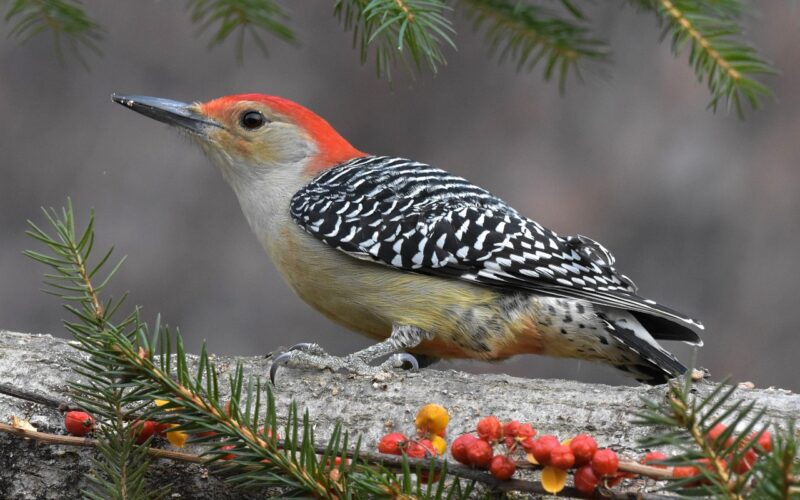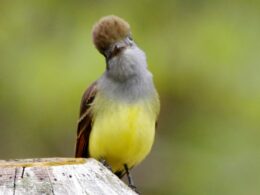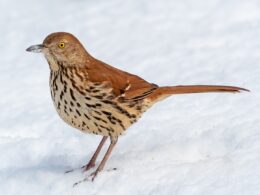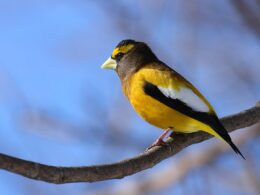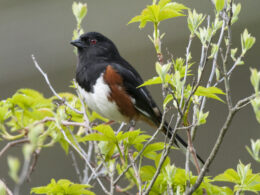Last Updated on January 17, 2024 by Greg Gillson
Feeding birds in winter is an enjoyable activity. Are you ready to try it?
This article tells you how and why to feed birds in winter in North Carolina. I’ll show you the birds you can expect. And I’ll show you what bird foods and feeder setup is best for attracting winter birds in North Carolina.
Winters in North Carolina are quite cool. Snow occurs occasionally in the lowlands, but is regular in the higher elevations. As an example, the average high temperature in Raleigh in January is 50° F. The average low in January is 30° F.
You’ll want to keep your bird feeders well-stocked in winter!
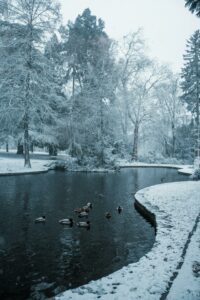
Why feed winter birds in North Carolina?
North Carolina has an abundance of native bird life. You can enjoy a view of their daily lives by bringing them to your backyard feeder. Viewing wildlife is good for your mental health!
The most common winter feeder birds in North Carolina are actually year-round residents. They will come to your feeder all year. However, these birds are often easier to observe when they come to feeders in winter. This is because they appreciate the food at the feeder when natural food sources are harder to find.
Not all birds at your feeder in winter are found year-round. Many birds migrate north in summer to breed in Canada. They then return south in winter. Many of these wintering birds are young that hatched the past summer. These young birds are still learning to find food throughout the year. They will quickly learn that there is food at your feeder!
Feeding birds often leads to improving your landscaping to make it more attractive and safe for birds. Your concern for the environment helps birds and other animals to survive.
What birds come to feeders in winter in North Carolina?
North Carolina is blessed with an abundance of wintering birds. Below I will show photos and describe identification of the most common feeder birds.
There are also several other common backyard birds in North Carolina that don’t usually visit feeders. They will be attracted to your landscaping where they may find insects to eat, some berries, or a safe place to build a nest. Many birds that don’t visit feeders come to bird baths.
I have another article about all of the common bird species found in your backyard all year long. They are in my article: Common backyard birds of North Carolina. I will link to it again at the end of this article so you can check out that information.
Here are some of the most common birds that visit feeders in winter in North Carolina.
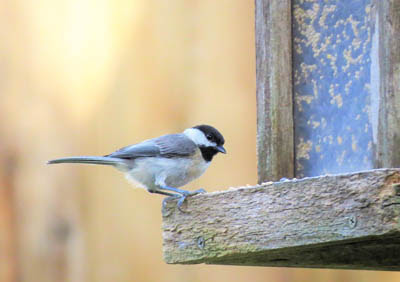 |
| Carolina Chickadee Image by GeorgeB2 from Pixabay |
Carolina Chickadee
Let’s start with a bird native to the southeastern United States. In winter you’ll find small flocks of these cute little acrobats hanging from the tips of branches and shrubs. They often form the core of mixed species flocks in winter. These flocks also contain titmouses, kinglets, creepers, and nuthatches.
They like many kinds of woods and trees, both deciduous and coniferous. They are common in residential areas. They are year-round residents in North Carolina below 3500 feet of elevation.
Their size is small. Their shape is plump with large head and long tail. The bill is short and stout. Feet are large and strong. Carolina Chickadees are gray above and paler below. The white side of face is set off by a black cap and bib.
These birds are very talkative. Their common call is a rapid chickadeedeedeedeedee.
Carolina Chickadees eat black oil sunflower seeds and suet. They will eat from any kind of feeder.
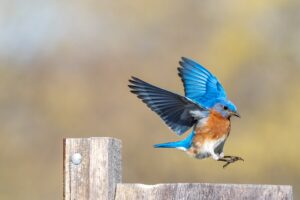
Eastern Bluebird
If you have some open farmlands adjacent to your home, you may attract Eastern Bluebirds to your backyard. If so, you’ll want to set up some bird houses in summer.
These birds are found in orchards adjacent to open fields and pastures. They may be found in open pine forests and parks. They are year-round residents in North Carolina.
Bluebirds are pudgy and a bit larger than House Finches or sparrows. They have a large head and short bill. The tail is rather short. They are blue above with rusty orange on the throat and across the breast.
Their call is a mellow rising chur-lee.
They hunt insects by perching quietly on a fence or low tree branch, then dropping on them on the ground. You can attract Eastern Bluebirds to your platform feeder by offering a dish of fruit, such as raisins, blueberries, cranberries, orange slices, and cherries. They also love mealworms. They love bird baths, too.
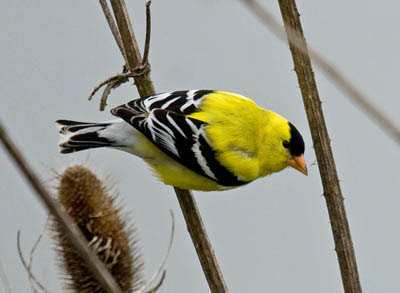 |
| American Goldfinch. Greg Gillson. |
American Goldfinch
I’ve selected a photo above of the bright yellow male in his summer plumage. In winter the yellow feathers are replaced with dull tan feathers. The wing feathers are a duller brownish-black. They really look different!
These goldfinches love weedy fields and pastures, often near water. They are found year-round in North Carolina. However you may notice some changes in abundance throughout the year. North Carolina is right on the southern edge of the breeding range. So they may actually be more common in winter or migration.
Goldfinches are tiny birds. They are compact, a bit plump, with a short neck and big head. The tail is short and deeply forked. Winter birds are pale tan with dark brown wings and two tan wing bars. Males have a touch of yellow on the throat.
They are found in flocks in winter. Birds in flocks give twittering calls and a rising whiny per-weee. The call in flight is a lilting per-chik-o-reee.
American Goldfinches visit backyard feeders for Niger seed. Feed this seed in a special “thistle sock” of finch feeder. They also love black oil sunflower seeds from a tube feeder.
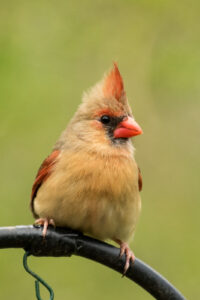
Northern Cardinal
This larger bird (not as big as a robin, though) is one of the most common and well-known backyard birds in the East.
They are found year-round in open deciduous woods, parks, and backyards in North Carolina.
Birds usually appear slightly plump with a large full tail. The head sports a fancy crest and a large orange cone-shaped bill. Males are bright red with a black face and throat. Females are dull buffy brown, but have the crest and over-large orange bill.
They sing all year. One of the most common songs in a whistled birdy birdy birdy refrain.
Northern Cardinals eat a wide variety of seeds, including larger seeds. They eat black oil sunflower seeds, striped sunflower seeds, and safflower seeds, among others. They like platform feeders best but will eat from hopper feeders or on the ground.
 |
| Mourning Dove. Greg Gillson. |
Mourning Dove
These doves are about a foot long, from bill tip to tail tip. They are common backyard birds across the United States. You may see them perched on telephone wires in towns.
They also live in countryside, farms, wooded river edges, almost everywhere at lower elevations that isn’t thick forest. They are year-round residents in North Carolina.
These pigeons have thick bodies. But they have a little round marble head on a long neck. The tail is very long and pointed. They are fawn-brown above, slightly paler and pinker below. They have black spots on the inner upper wing feathers. The legs and feet are dark pink-red.
Their song is a sad sounding cooing, boo hoo hoo.
Mourning Doves eat black oil sunflower seeds, cracked corn, and other grains. They prefer platform feeders but will squeeze on to hopper feeders, or feed on the ground below the feeder.
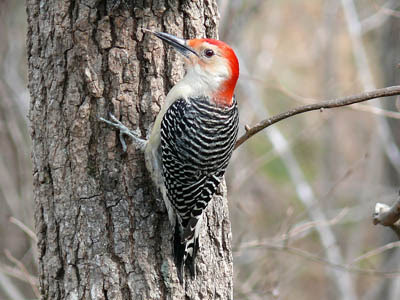 |
| Red-bellied Woodpecker. Image by skeeze from Pixabay. |
Red-bellied Woodpecker
This woodpecker is common at feeders in the East. It is active in all parts of a tree.
These birds are found in deciduous and mixed woodlands, especially near streams. They are also common in towns. They are year-round residents in North Carolina.
These birds are fairly long and slim–not as chunky as some other woodpeckers. The have a long bill. The tail is short. They are smaller than flickers, but larger than Hairy Woodpeckers. Birds are very pale. The back is zebra-striped black-and-white. The crown is red, more extensive on the male.
A common call they give is a rolling churrr.
Red-bellied Woodpeckers eat insects, but also acorns, nuts, and berries. At your bird feeder they will eat sunflower seeds, peanuts, and fruit. They prefer a platform feeder.
 |
| White-breasted Nuthatch. Greg Gillson. |
White-breasted Nuthatch
Nuthatches are well known for crawling over and down branches and tree trunks in their search for food on the bark of trees.
These birds are common in deciduous woods. They also are found in open pine forests, but not usually in other conifers. They are year-round residents in North Carolina.
These are short, stocky birds, neckless with a large head. They have almost no tail. The bill is long and slender, but slightly chisel-shaped. The legs and feet are strong, helping them cling firmly to the branches. They are blue-gray above with a black crown. The face and underparts are white. There is a touch of rusty on the vent.
A common call is a series of nasal yank yank notes.
White-breasted Nuthatches love black oil sunflower seeds that they take one at a time from a tube feeder. They fly off to a branch to hold the seed with their feet and pound it open with their bill. They also like nuts.
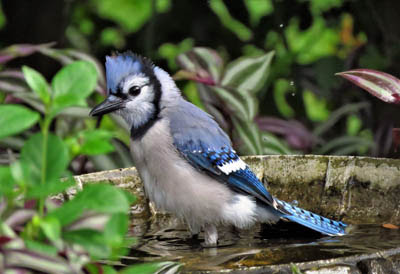 |
| Blue Jay. Image by skeeze from Pixabay. |
Blue Jay
Here is another common and easily recognized bird in the East. In winter this bird is loud and boisterous. They form small roaming flocks in winter.
These birds are common in deciduous woods, residential areas, and parks with large trees. They are year-round residents in North Carolina.
They are rather large for backyard birds. They have a large full tail, big head and strong bill. They have fairly long legs and strong feet. Blue above and white below with a black chin strap. Their most obvious mark is their crested head. In flight you will notice white wing patches and tail corners.
They can be noisy and give several calls. The most memorable is a raspy jay jay jay call.
Blue Jays visit feeders for sunflower seeds and peanuts or other nuts. Since they are larger birds they prefer platform or larger hopper feeders. In fall they often raid bird feeders and carry away large gulletfuls of seeds to go bury in caches in the woods. They will dig them up later in winter to eat.
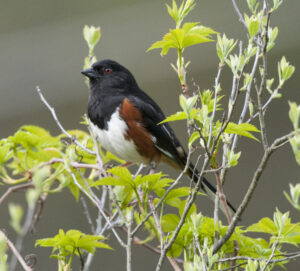
Eastern Towhee
These large sparrows spend much of their time on the ground scratching for animal and vegetable foods in the leaf litter. The red eye is a feature that grab’s many people’s attention. Though there are many birds with red eyes, the towhee is the only bird that is widespread in backyards.
Widespread in the East, they favor brushy tangles in dry oak woodlands. But they may be found wherever there is leaf litter under low bushes, including mature residential landscaping. They are year-round residents in North Carolina.
Towhees are plump with a long full tail and round or slightly crested head. They maintain a rather horizontal posture. Males are black above with a wedge of white in the wing. The sides are rusty orange and the belly white. While flushing away low to the ground you may see the white spots in the outer spread tail.
You may first notice the towhee by its whiny whistled call from the bushes, tow-eeee.
Eastern Towhees will visit low platform feeders for black oil sunflower seeds. But they may rather be content to pick up fallen seeds from under the feeder. Or they may prefer to rummage in the leaves under bushes at the edge of the yard.
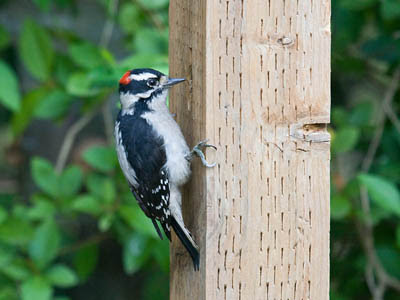 |
| Downy Woodpecker. Greg Gillson. |
Downy Woodpecker
This little guy is found across North America, except for deserts and deep forests. It is common at bird feeders.
These birds like deciduous woods, especially damp stream bottoms. They are found in residential areas with trees, even as small as willows. They are year-round residents in North Carolina.
This is a small woodpecker, less than 7 inches long from bill tip to tail tip. They are compact with a big head and small chisel bill. The tail is short. The head is striped black and white with a red spot on the nape of the male. The shoulders are black. The back is white. The wings are black with white spots. The under parts are white. The tail is black with white outer tail feathers.
Birds give a sharp pik call, and a soft descending rattle of similar calls.
Downy Woodpeckers normally find insects on the bark of small trees and branches. They love suet. So a suet feeder will attract them. They will also eat black oil sunflower seeds from a hopper feeder.
 |
| House Finch. Greg Gillson. |
House Finch
These cheerful songsters are common in towns across the United States.
Wherever people are in the U.S. there will be House Finches. They like residential areas, farms and, in the West, arid regions. They are year-round residents in North Carolina.
This finch is rather thin with a rounded head. The bill is thick and rather short and curved on the upper mandible. The tail is medium length and squared or slightly notched.
Birds are streaked with dusty brown over gray on the upper parts. The under parts are off-white and streaked with dusty brown. Females don’t have much of a face pattern. Males show orange-red forehead, breast, and rump.
These birds are always talkative in family groups or small flocks. They chirp similar to House Sparrows and have a rising wheat call.
House Finches love black oil sunflower seeds from tube feeders. They will also eat Niger seed from thistle socks. They come readily to bird baths to drink water.
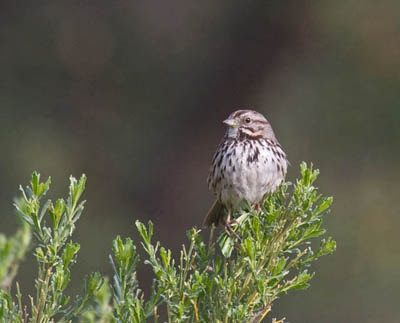 |
| Song Sparrow. Greg Gillson. |
Song Sparrow
These little birds are common across North America. You may see them hopping furtively below bushes at the edge of your yard.
They are found in tangles and brush in open woods. They are especially numerous in marshes and riparian areas. But they also occur in residential areas. They are year-round residents in North Carolina.
They are rather plump with a longer round-tipped tail. They have a striped head in a pattern that is complicated to describe. Heavy streaks below converge in a central breast spot. Upperparts are pale gray-brown with dark brown streaks. The under parts are white with heavy dark brown streaks.
Their common call is a rising nasal chimp call.
Song Sparrows eat smaller mixed seeds such as millet in hopper or platform feeders. More often, you may note them on the ground under your feeder, never far from cover.
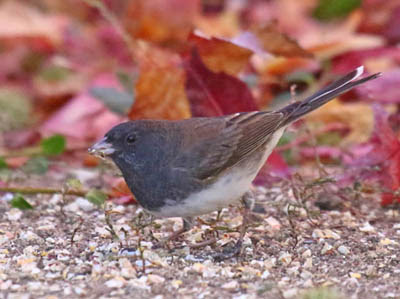 |
| Dark-eyed Junco. Greg Gillson. |
Dark-eyed Junco
These little birds come in winter flocks to your feeder.
These birds breed across Alaska and Canada and in the higher mountains. Some breeding birds reach all the way south to the highest mountains of far western North Carolina, where they may be found year-round. Otherwise, juncos only visit in the winter.
They are small and plump. The head is fairly large and they look to have no neck. The tail is short and sports several white outer tail feathers that they fan and flash nervously. The little conical bill is white or pink. The legs and feet are pink. In the East, juncos are all-gray with white bellies. Females may have slightly brownish backs.
They give soft twittering calls and a soft smacking tik.
Dark-eyed Juncos feed on small mixed seeds in hopper and platform feeders. Most often, though, you may notice them on the ground under the feeders.
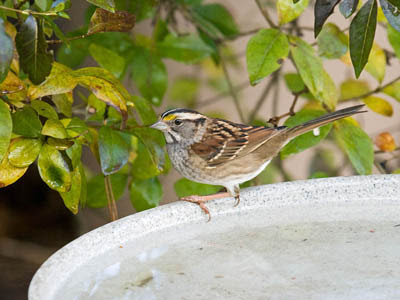 |
| White-throated Sparrow. Greg Gillson. |
White-throated Sparrow
These larger sparrows breeds across Canada and in the Northeast. Then they move south in winter to visit bird feeders.
In winter, birds are found in roadside tangles, wood edges, and backyards. They often find an active bird feeder in fall. Then they stay there all winter and into mid spring. In North Carolina they are only found fall through spring.
They are fairly long sparrows with a long tail. They have a fairly large head with a rounded forehead. The bill is conical, but not overly large. The upper parts are tan with dark brown stripes on the back. There are two thin wing bars. The head is striped black and white or black and tan. The breast is gray and offset by a well marked white throat.
The call note is often given at dawn and dusk. It is a very loud spink!
White-throated Sparrows like to eat black oil sunflower seeds on platform or hopper feeders.
 |
| Tufted Titmouse. Image by anne773 from Pixabay. |
Tufted Titmouse
These are plain gray birds related to chickadees. Like chickadees, they will visit your feeders regularly.
The habitats they inhabit include oak and deciduous woods in the eastern half of the United States. They frequent residential backyards. They are year-round residents in North Carolina.
These birds are small, but a bit larger than chickadees, to which they are similar in shape. The are plump with a large head and short stout bill. The tail is medium length and squared off. They have a wispy crest. The legs are strong and the toes are large. These birds are colored blue-gray above and pale below. There is some black on the forehead and around the eye.
They give soft husky chickadee-like notes. They sing throughout the year, a whistled Peter Peter Peter.
Tufted Titmouses love black oil sunflower seeds from tube or hopper feeders. They will also eat suet.
Setting up a winter bird feeding station in North Carolina
Several of the smaller bird species in North Carolina would prefer black oil sunflower seeds from a tube feeder. Tube feeders are harder for larger birds to eat from. Smaller birds can get food more easily with less competition. Such birds include the House Finch, Tufted Titmouse, Carolina Chickadee, White-breasted Nuthatch, and American Goldfinch.
I would also set up a suet feeder. Birds that would like the suet include the White-breasted Nuthatch, Downy Woodpecker, Red-bellied Woodpecker, Carolina Chickadee, Tufted Titmouse, and Blue Jay.
I would also set up a low platform feeder with roof over it. There I would feed mixed seeds, including white proso millet. The sparrows would like this feeder and food. In winter you would attract Eastern Towhee, Song Sparrow, Dark-eyed Junco, White-throated Sparrow.
Add in some sunflower seeds and you’ll attract Mourning Dove, Northern Cardinal, Carolina Chickadee, and White-breasted Nuthatch.
And don’t forget to provide a bird bath with drinking and bathing water.
Wrapping Up
North Carolina offers a fantastic birding experience during winter! With diverse habitats and a mix of resident and migratory species, there’s plenty to see and enjoy. Here are some tips for making the most of your winter bird watching if you are brave enough to venture out of your backyard:
Top locations:
Eastern Coast: Pea Island National Wildlife Refuge, Nags Head Woods Ecological Reserve, Jockey’s Ridge State Park – excellent for waterfowl, shorebirds, and raptors.
Mountains: Grandfather Mountain, Mount Mitchell State Park, Blue Ridge Parkway – ideal for seeing high-elevation birds like Red Crossbills, Pine Siskins, and Northern Saw-whet Owls.
Piedmont Region: Umstead State Park, Eno River State Park, Duke Gardens – great for resident songbirds like chickadees, nuthatches, and finches, as well as wintering warblers and sparrows.
What to see:
Waterfowl: Ducks, geese, swans, and loons congregate along the coast and inland lakes. Look for Snow Geese, Canada Geese, Buffleheads, and Tundra Swans.
Raptors: Hawks, eagles, and owls are more active during winter. Keep an eye out for Red-tailed Hawks, Northern Harriers, and Bald Eagles.
Songbirds: Resident species like chickadees, nuthatches, and titmice are easy to spot at feeders and in woodlands. Wintering warblers and sparrows like Yellow-bellied Sapsuckers, White-throated Sparrows, and Dark-eyed Juncos add variety.
Finches: Pine Siskins and American Goldfinches flock to feeder offerings, especially sunflower seeds and thistle.
Other surprises: Keep an eye out for unexpected visitors like Northern Gannets along the coast, Common Redpolls in the mountains, and Purple Finches in backyards.
Frequently Asked Questions
Do birds migrate to NC in winter?
Yes, many birds migrate to North Carolina in the winter! In fact, the state becomes a winter haven for a variety of species that breed further north during the warmer months. Here are some of the reasons why:
Milder climate: Compared to their northern breeding grounds, North Carolina’s winters are generally milder, with fewer harsh storms and more abundant food sources. This makes it a much more hospitable environment for birds to survive and thrive during the colder months.
Diverse habitats: North Carolina boasts a wide range of habitats, from the Atlantic coast and barrier islands to the rolling Piedmont hills and the majestic Appalachian Mountains. Each habitat provides unique food and shelter resources for different bird species.
Abundant food: The state’s varied landscapes offer a plethora of food sources for wintering birds. Coastal areas teem with fish, shellfish, and marine invertebrates, while forests and fields provide berries, seeds, and insects.
Here are some examples of birds that migrate to North Carolina in the winter:
Waterfowl: Ducks, geese, swans, and loons flock to the state’s extensive coastline and inland lakes. Look for species like Snow Geese, Canada Geese, Buffleheads, and Tundra Swans.
Raptors: Hawks, eagles, and owls are more active during winter. Keep an eye out for Red-tailed Hawks, Northern Harriers, and Bald Eagles.
Songbirds: Some warblers and sparrows, such as the Yellow-bellied Sapsucker, White-throated Sparrow, and Dark-eyed Junco, migrate south to North Carolina for the winter.
Finches: Pine Siskins and American Goldfinches can be found at feeders and in coniferous forests during the winter months.
How do I prepare my yard for visiting birds in winter in North Carolina?
Transforming your yard into a winter haven for feathered friends in North Carolina is a rewarding and enriching experience! Here are some tips to prepare your yard and attract a variety of bird visitors during the colder months:
Food and Water:
Offer a variety of high-energy foods: Sunflower seeds, millet, nyjer seeds, and suet cakes are favorites among many birds. Consider providing different feeders for different sizes and beak types.
Don’t forget fruits and nuts: Slice oranges, apples, and grapes for robins and other fruit-loving birds. Offer peanuts and pecans for jays, woodpeckers, and nutcrackers.
Keep water sources fresh and accessible: A heated birdbath will be a magnet for thirsty birds during freezing temperatures. Keep ice at bay with a birdbath heater or by regularly changing the water.
Shelter and Protection:
Plant native trees and shrubs: Native plants provide berries, seeds, and cover for birds throughout the winter. Choose species that produce fruit during cold months, like dogwood, holly, and viburnum.
Create brush piles: Loose branches and twigs offer refuge from predators and cold winds. Birds will also use them for nesting materials in spring.
Put up birdhouses: Nest boxes provide safe havens for breeding birds in the spring and shelter for roosting during winter. Choose appropriate types and locations for different bird species.
Attract Specific Birds:
Hummingbirds: Hang hummingbird feeders filled with diluted sugar water near brightly colored flowers like red salvias or trumpetvine.
Woodpeckers: Offer suet cakes and mount woodpecker feeders on tree trunks. Consider planting trees with bark suitable for drumming, like dead snags or pines.
Finches: Scatter nyjer seeds or use thistle feeders to attract these colorful seed-eaters. Consider planting coniferous trees like pines and spruces for additional food sources.
Do finches stay in NC in the winter?
Not all finches stay in North Carolina in the winter, but some do! It depends on the specific species:
Finches that stay in NC:
House Finch: These familiar backyard birds are permanent residents in North Carolina, meaning they stay year-round. You’ll likely see them at feeders and in a variety of habitats, including woodlands, fields, and urban areas.
American Goldfinch: These bright yellow finches with black wings are common summer residents in North Carolina, but many stay through the winter, especially in the eastern and coastal regions. They flock to feeders and love sunflower seeds and nyjer seeds.
Pine Siskin: These small, streaked finches are irregular winter visitors to North Carolina. They tend to flock in coniferous forests and at feeders, attracted to thistle and other small seeds.
Finches that migrate from NC:
Purple Finch: These beautiful reddish-purple finches with a streaked chest breed further north and migrate south to North Carolina in winter. They can be found in a variety of habitats, including woodlands, parks, and backyards.
So, whether or not you see finches in your North Carolina yard in the winter depends on the species. House finches and American goldfinches are reliable winter visitors, while others like pine siskins and purple finches are less predictable. Keep an eye out and you might be surprised by the variety of finches that grace your feeders and trees during the colder months!
Related articles:
The most common backyard birds in North Carolina
My recommended bird feeder setup
Bird seeds that attract the most birds
Different kinds of bird feeders for different birds
Bird baths that birds actually use






